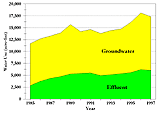
| ch. 5, pp. 45 - 46 |
Residential Use Single family residents account for approximately 75 percent of residential demand in the Tucson area. Multifamily residential demand makes up the balance. These include apartment complexes, duplexes, triplexes, townhouses and condominiums. Their use is typically about 60 percent of the single family residential use rate. Multifamily complexes use less water per person in part because landscaping is generally limited to common areas, and some water uses occur away from the residence; e.g., apartment dwellers are more likely to use and car washes.
During the 1970s and 1980s new housing construction shifted towards multifamily dwellings. This increased construction of lower water-use housing promised to reduce gpcd rates. This trend, however, did not continue. Economic expansion and much lower mortgage rates caused single family home construction to rebound. In addition, the majority of multifamily units being constructed are more luxurious units which are more likely to have large turf areas, pools and other water-using amenities. Older homes tend to consume more water both indoors and outdoors than newer homes. They generally use more water outdoors because of larger lots with more turf and landscaping. They use more indoors because they are less likely to have low-water use fixtures such as ultra low flush (ULF) toilets designed to use 1.6 gallons per flush. Homes built after 1975 are less likely to have lawns, and homes built after 1989 are required to have ULF toilets. Nonresidential Use Non-residential demand generally consists of turf facilities (golf courses, cemeteries, etc.), water features in public rights-of-way and commercial establishments. Non-residential demand for large providers averaged 41 gpcd in 1995. Tucson Water’s non-residential demand decreased by six gpcd from 1985 to 1995. For other large providers, however, non-residential demand increased by 11 gpcd. Tucson Water has been able to reduce its gpcd rate by switching some golf courses and other facilities to effluent. (Although considered water, effluent does not count in the official calculations.) Other large providers are serving an increasing number of golf courses but do not have access to reclaimed water. As a result, their water use appears greater. Some areas served by large municipal providers are experiencing a transition from bedroom communities to areas with more retail and commercial activity, a change that is reflected in their water use. The 35 golf courses in the area account for about ten percent of municipal water use in TAMA. The total amount of water used on TAMA golf courses has increased from 11,700 acre-feet in 1985 to 17,000 acre-feet in 1997. (See Figure 5-3.) Of the total amount of water used on golf courses in TAMA, the share of effluent increased from 24 percent in 1985, peaking at 38 percent in 1990, and has since fallen to 35 percent in 1997.
The number of holes of golf in TAMA has increased by 35 percent since 1985. Golf course design in the area has shifted towards more desert-like courses, incorporating fewer water hazards and significantly more low-water use plants along fairways instead of turf. In addition, the average number of acres of turf per hole has decreased from 5.9 in 1985 to 4.8 in 1997. However, reductions in water use resulting from these changes have been offset by a large increase in the percentage of golf course turf which is overseeded with winter rye grass, from 21 percent in 1985 to 66 percent in 1997. The water use per hole of golf has increased over time since 1985, in part due to variations in weather. Other large-scale turf facilities include parks, cemeteries and schools. For legal reasons Arizona Department of Water Resources (ADWR) divides turf facilities into industrial and municipal categories according to whether or not they are served by municipal water providers. All these turf facilities use about 20,000 acre-feet of water, about 33 percent of which is effluent. The remainder is groundwater. Patterns of water use for retail and commercial establishments vary widely, but often include water for sanitary and landscaping needs. The number of employees often is a significant factor in business water use. Partly because water use patterns vary significantly among businesses, water audits tailoring conservation measures to particular needs are an effective strategy for reducing business water use. Under the Groundwater Management Act, ADWR sets goals for per capita water use by municipal water providers, but cannot regulate individual customers. Large providers can choose among four water conservation programs. Most often selected is the Total GPCD program, which sets targets for reductions in per capita water use for each water provider based on an analysis of conservation potential for that provider. Tucson Water and Metro Water have selected the non-per capita conservation program; they do not have to meet specific per capita water use targets, but must implement a range of conservation measures. Small providers, which account for four percent of total municipal water use, are regulated differently than large providers. Small providers are required to reduce waste and encourage conservation, but they generally lack the resources to implement conservation programs. Other ways ADWR tries to balance supply and demand include requiring developers to demonstrate that renewable supplies are available to serve the development; that water use is consistent with TAMA’s management plan and goal; and that the developer has the financial capability to construct needed water facilities. These Assured Water Supply (AWS) rules are designed to work with the conservation programs to reduce mining of groundwater. Historically, Tucson has been largely dependent on groundwater, a mostly non-renewable supply. In the past twenty years, however, effluent use has increased and CAP water has arrived in the area.
|


